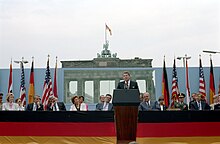The Cold War/"A Forward Strategy to Freedom"
Ronald Reagan, a Republican, took over the American presidency in 1981, from the Democrat Jimmy Carter. He believed that the USA had a special, God-ordained position in the world - that of an ambassador for freedom. Because of this, he immediately went on the offensive against world Communism, saying, in 1984 in Berlin:

| “ | Mr. Gorbachev, tear this wall down. | ” |
Central America
editOne way by which he seeked to accomplish this was by combatting the advance of Communism in Central America. In 1983, when Cuban-backed forces staged a coup on the small island of Grenada, Reagan diverted a troop carrier of marines, on their way to Israel, to invade the island. The invasion was a straight-forward success. Reagan also covertly backed rebels against the Sandinista government in Nicaragua for most of his presidency, despite opposition from both Congress and the Senate.
SDI
editReagan also went on the offensive in the Arms Race, instigating the Strategic Defense Initiative (SDI) in 1983. This was an attempt to develop a space-based missile defense system, which would allow the USA to shoot down any incoming missiles using lasers. It never succeeded, but it did bring the USSR to the bargaining table, as they could not afford to keep up with the Arms Race. Together with the Soviet financial problems, SDI ended the Cold War.
The Cold War
Introduction - Background - Strategy - Truman Doctrine - Marshall Plan - Berlin Blockade - Korean War - Hungarian Uprising - Cuban Missile Crisis - USSR under Gorbachev - USA under Reagan - Arms Race - Space Race
Cover - Contents - Study Guide
Please read the page creation guidelines before creating a new page.